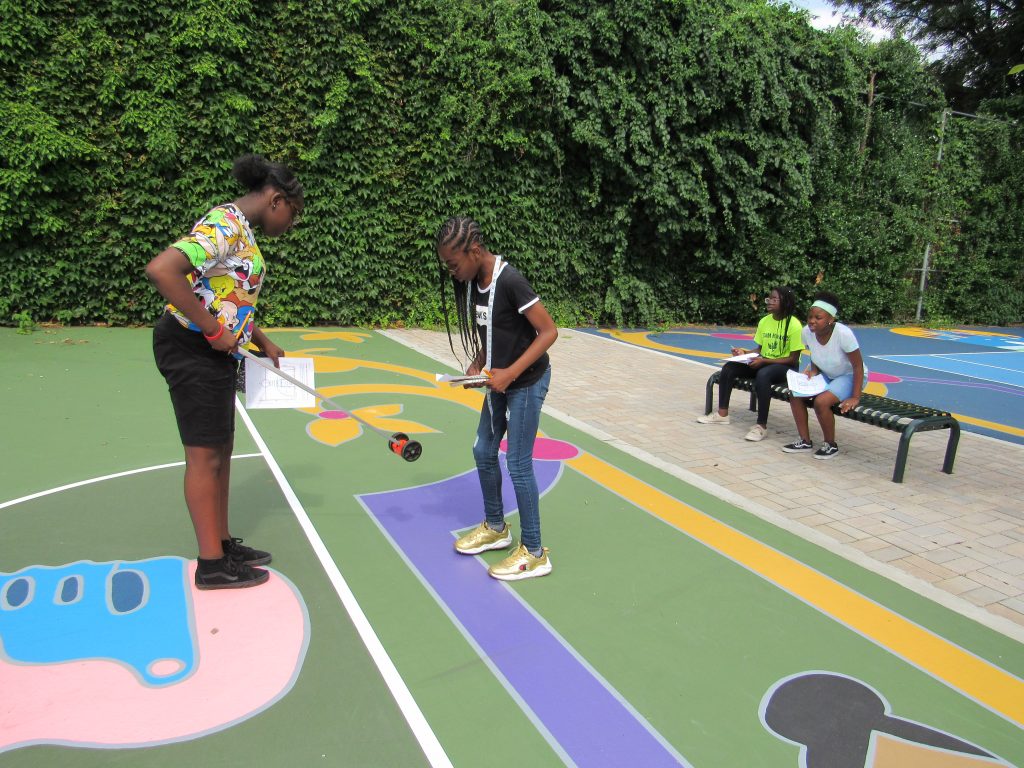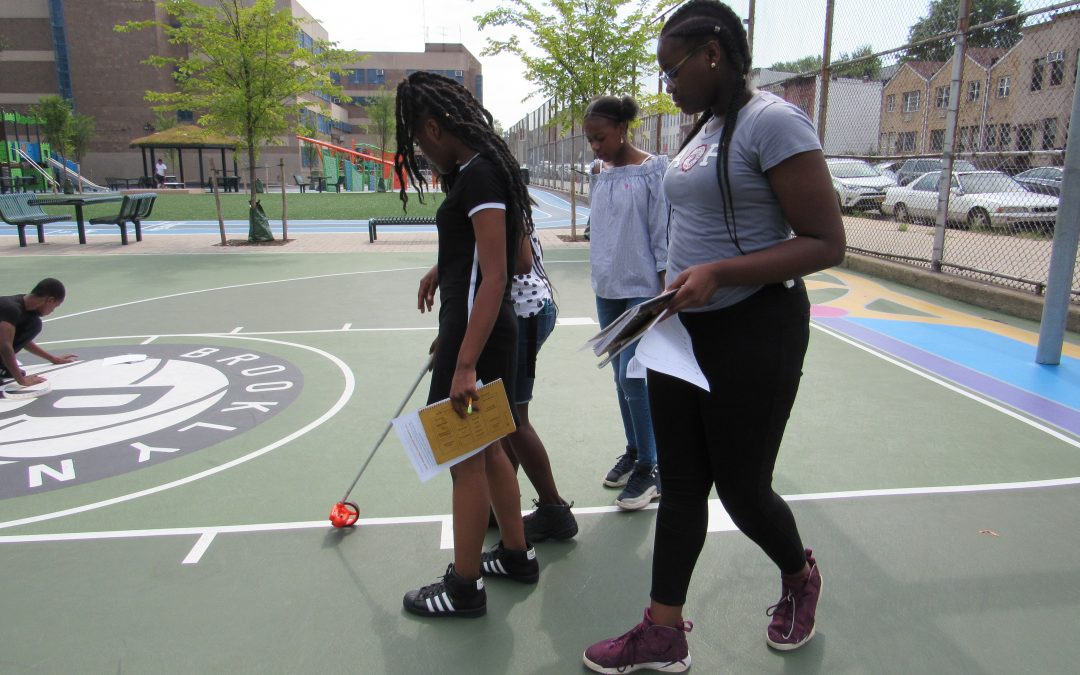By. Jan Cohen and Tiffany Briery
Place-based math learning is a topic that deserves attention. Whether at a park, community space, historic site, museum, or playground, place-based math experiences spark student interest, reinforce mathematical thinking, excite mathematical imagination, electrify mathematical senses, and introduce a new lens through which students see and understand their environment. The convenience of a school’s playground, offering an immediate outdoor space that requires no permission slips to visit, invites an especially prime place-based math learning opportunity.
Sharing a common understanding and vision about this educational need and opportunity, UrbanMathTrails, a place-based math learning organization that promotes authentic connections between math and the environment, partnered with The Trust for Public Land’s New York Playgrounds Program, which builds student-designed playgrounds at public schools across New York City, to activate more than 200 school playgrounds as innovative outdoor classrooms. The result is an innovative, versatile, and engaging K-5 Math in the Playground curriculum which rolled out to New York City teachers in September 2019.
Playgrounds are perfect environments to change the way students experience math for many reasons. Learning is highly visual and kinesthetic. Students can see the content and move around it while learning. The content embedded in the natural and built environments is varied in terms of geometry, size, scale, and materials. There are myriad shapes, angles, ratios, measurements, quantities, patterns, and arrangements to explore.
Teachers and communities are creating place-based opportunities for students in many different settings as the foundation for the study of language arts, social studies, science, and other subjects. More than just providing a change of scenery, outdoor place-based learning leverages local places as a learning ecosystem for students, enabling them to experience the relevance of academic content while developing skills in critical thinking, communication, collaboration, and problem-solving.
Studies have shown that outdoor education benefits school performance, impacting everything from standardized test scores to student attitudes toward academics. When students take an active part in the learning process, they are more motivated to learn, which increases their self-confidence and enables a deeper, more effective understanding of the material (James and Williams, 2017). Active learning applied to real situations increases knowledge retention and recall (Broda, 2011).
Math, however, isn’t typically a subject that leverages the power of place to promote learning. Place-based learning is not a common curricular tool in the math education arsenal but should be given the benefit of putting acquired math skills to use in real-world situations. Not only is it a way to help students connect with and get excited about math, it’s crucial for thinking about important mathematical concepts, seeing the interconnected nature of mathematics, engaging students in mathematical modeling, and preparing students to use mathematics beyond the classroom.

Playgrounds offers multiple opportunities for interesting activities using non-standard (hand span, arm span, step length) and standard measurement units (feet and meters). A few of these activities include:
- Compare various non-standard units and assess which are best for what application. Paper clips may be appropriate non-standard measurement units for pavement tiles, but not for the length of a basketball court.
- Convert units of measurement using the metric and U.S. measurement systems. Using tape measures denominated in inch and centimeter units, students convert lengths, widths, and height and practice division to solve application problems.
- Compare the dimensions of a professional basketball court to a school basketball court. This hones student measurement skills while they learn about scale and ratios.
- Compare lane lengths on a running track to assess starting positions in each lane to ensure that competitors run the same distance.
- Find the shortest path between points. Shortest path algorithms have many real-life applications, including mapping software, road networks, computer networks, and logistics planning.
- Explore the relationship between perimeter and area, non-proportional relationships, which students recognize while comparing them.
- Solve problems about area and volume for planting and landscape maintenance, which demonstrate the planning and math that underlie garden cultivation.
- Collect data to build a scale model. Students practice their measurement skills, organize information, apply ratio and proportional analysis, and learn about the engineering design process.
- Calculate slopes. By learning how to measure changes in elevation, students are exposed to another engineering concept.
- Find heights using corresponding shadows. Proportional reasoning is fostered through activities such as this, which enrich conceptual understanding of ratios.
- Practice estimating lengths and distances and comparing them to actual measurements. Estimating skills are essential to developing number sense and necessary when exact answers are unattainable or impractical.
Playgrounds also provide mathematically-rich play equipment and flexible use spaces like pavements, turf fields, and hardcourt areas for meaningful opportunities to apply geometry concepts and skills. For example, students can:
- Analyze and compare shapes. Modern playground design offers opportunities for interesting exploration of shapes and their mathematical properties.
- Identify and measure different types of angles. Whether acute, obtuse, right, or straight, a playground’s structures and layout allow students to explore, classify, and compare a range of angles in a physical environment.
- Explore the properties of polygons, polyhedrons, circles, and cylinders and evaluate the properties of space from the perspective of two- and three-dimensional shapes and their relative positions. Learning about the differences between two- and three-dimensional shapes is facilitated by actual observation of their differences in the playground equipment and athletic courts.
- Learn and practice key geometric terms. When students are challenged to share ideas and communicate math orally or in writing, it clarifies their understanding of the fundamental concepts of the shape of individual objects, the spatial relationships among objects, and the properties of surrounding space.
- Explore symmetrical relationships. Symmetry is important in an organizational sense in nature and in the art, architecture, and design found in cultures around the world and throughout human history. As such, it’s one of the most powerful and pervasive concepts in mathematics.
Playgrounds also provide fun opportunities for children to collect data about playground layouts, facilities, and participation and graph the results. They can even model the coordinate grid and histograms with their bodies. Students can play human number line games to order integers, fractions, and decimals. They can also estimate approximate positions on the number line between a range of numbers. By literally embodying these concepts, math becomes very concrete for students and much more enjoyable.

Although designed for The Trust for Public Land’s New York City school and community playgrounds, the more than 60 lessons included in the K-5 curriculum are easily adaptable to any playground site. The curriculum has been widely shared by The Trust for Public Land among New York City Department of Education early childhood educators, as well as among hundreds of members of the National Council of Teachers of Mathematics, the world’s largest mathematics education organization. Teachers, math support specialists and coaches, math interventionists, math club coordinators, and professors of STEM and math education around the world have requested the curriculum. The reasons are many:
- Find interesting ways to encourage the use of mathematics
- Use resources kids are familiar with
- Try a new source for project-based learning
- Identify new ways to integrate the real world into the classroom
- Try a new approach to active and engaged learning
- Find ways to use outdoor spaces as extended learning environments
- Identify innovative outdoor activities to keep kids engaged during recess
Responses to the curriculum all point to the versatility of the lessons in any playground setting and the different ways in which they can be used, namely, to reinforce skills, to introduce or review a topic, to pre-teach, or as an exit ticket at the end of a unit or an extension activity. The curriculum works with large math classes or small group instruction.
Take a break from math textbooks, the classroom, and your daily routine. Experience the power of place-based math learning on your school playground with a copy of the curriculum.
Works Cited
Broda, H. (2007). Schoolyard-enhanced learning: Using the outdoors as an instructional tool, K-8. Portland, ME: Stenhouse Publishers.
James, J. and Williams, T. (2017). School-based experiential outdoor education: A neglected necessity. Journal of Experiential Education, 40(1), 58-71. doi: https://doi.org/10.1177/1053825916676190
Author Bios
Jan Cohen is the founder of UrbanMathTrails, an education consulting firm that serves various institutions in the application of math in new contexts. Drawing upon an extensive background in math education (M.Ed., Brooklyn College), finance (M.B.A., Drexel University), and architecture (B.F.A., Cornell University), and a passion for the outdoors and the arts, Jan’s programs inspire children to discover math in the environment around them, including parks and other natural habitats, playgrounds, museums, buildings, and neighborhoods. Prior to founding UrbanMathTrails, Jan was a middle school math teacher for 16 years, following senior positions on Wall Street for 20+ years.
Tiffany Briery is the New York City Playgrounds Program Coordinator at The Trust for Public Land. Tiffany works with school communities to foster stewardship of future and existing community-designed playgrounds. Her role includes leading stewardship and gardening programs, helping teachers get their students engaged in their gardens, supporting participatory design, and fostering park activation by empowering communities to program their yards. Before coming to the New York City Playgrounds Program, Tiffany taught at The Brooklyn Urban Garden School and served as an educator at a variety of New York institutions. She holds an M.A. in Bioethics from New York University where she explored social and moral matters at the intersection of health and the environment.

